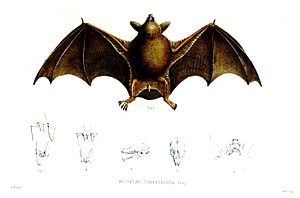Mystacina facts for kids
Quick facts for kids Mystacina |
|
|---|---|
 |
|
| New Zealand lesser short-tailed bat, Mystacina tuberculata | |
| Scientific classification |
|
| Kingdom: | Animalia |
| Phylum: | Chordata |
| Class: | Mammalia |
| Order: | Chiroptera |
| Family: | Mystacinidae Dobson, 1875 |
| Genus: | Mystacina Gray in Dieffenbach, 1843 |
| Type species | |
| Mystacina tuberculata Gray, 1843
|
|
| Species | |
Mystacinidae is a family of very special bats, known as the New Zealand short-tailed bats. There is one living genus called Mystacina. This group has two known species, but sadly, one of them is thought to have disappeared in the 1960s. These bats are about 6 centimetres (2.4 in) long and have soft, grey fur.
Unlike most bats that spend all their time flying, New Zealand short-tailed bats are quite unique. They spend a lot of time on the ground, walking and looking for food. They can even fold their wings away when they are not flying!
Meet the Species
There are two species of New Zealand short-tailed bats:
- New Zealand greater short-tailed bat, Mystacina robusta (This species is believed to be extinct, meaning it no longer exists.)
- New Zealand lesser short-tailed bat, Mystacina tuberculata (This is the living species.)
These bats are part of a very old group. Scientists have found fossils of their relatives, like Icarops, in Australia. This shows that their family has been around for a very long time, even when the supercontinent Gondwana was breaking apart, about 51 to 41 million years ago!
Amazing Adaptations
New Zealand short-tailed bats have some really cool features that make them different from other bats.
Ground-Dwelling Lifestyle
Most bats fly to find food, but these bats spend a lot of time on the ground. They are excellent at moving around on the forest floor. They can even fold their wings into a special leathery cover when they are not flying. This helps protect their wings while they explore on the ground.
Special Claws and Diet
Another unique thing about these bats is that some of their claws have an extra little bump. This might help them dig or climb trees. They are omnivores, which means they eat many different kinds of food. They munch on fruits, dead animals, and insects that live on the ground. They also enjoy pollen and nectar from flowers, which they can reach with their long, stretchy tongues.
Homes and Hibernation
These bats are good at making their own homes. They sometimes chew out burrows in rotting wood. They can also live in cracks in rocks or in the burrows made by seabirds. When winter comes, they are able to hibernate, which means they go into a deep sleep to save energy.
Life Cycle and Conservation
New Zealand short-tailed bats usually give birth to one baby each summer.
Sadly, these bats face dangers. In 2010, a feral cat was found to have killed many short-tailed bats in a forest near Mount Ruapehu. This shows how important it is to protect these unique creatures from threats in their environment.
See also
 In Spanish: Mystacina para niños
In Spanish: Mystacina para niños

